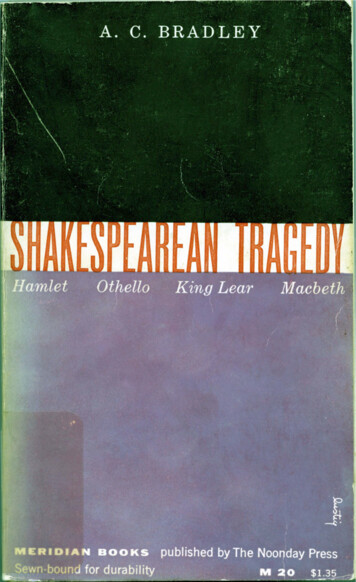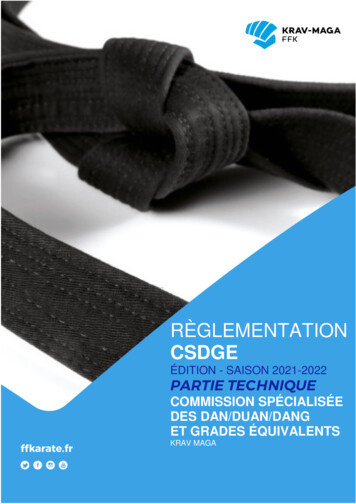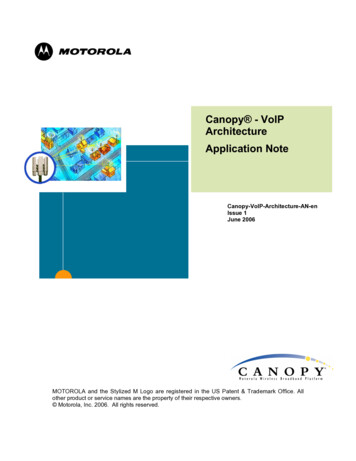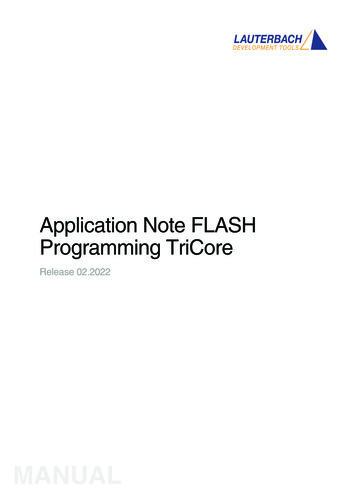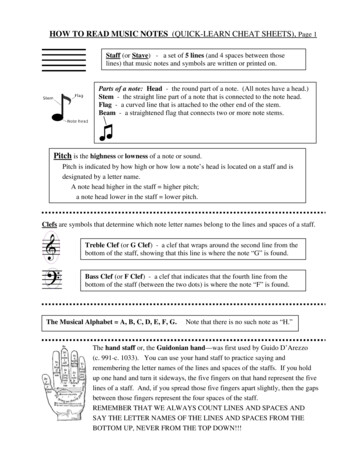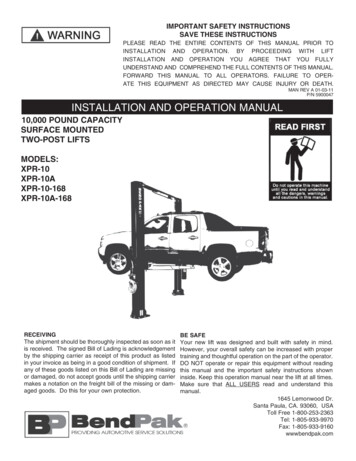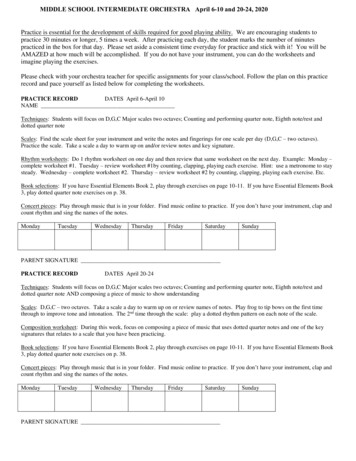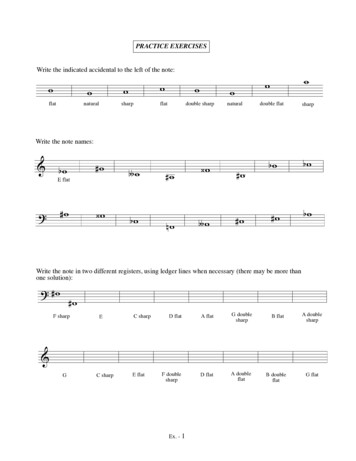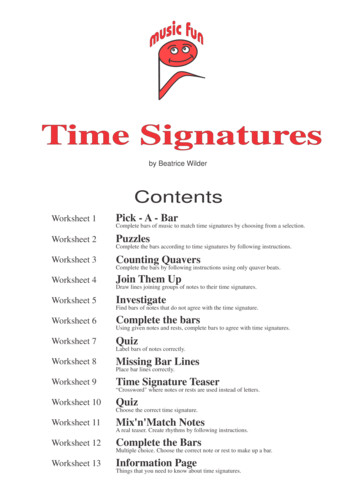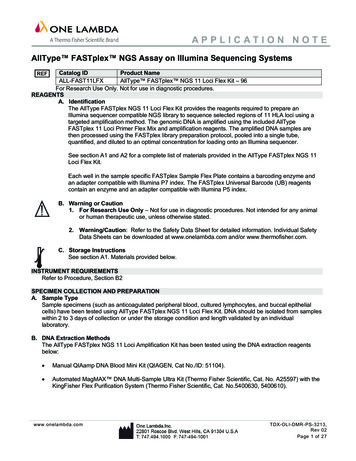
Transcription
APPLICATION NOTEAllType FASTplex NGS Assay on Illumina Sequencing SystemsCatalog IDProduct NameALL-FAST11LFXAllType FASTplex NGS 11 Loci Flex Kit – 96For Research Use Only. Not for use in diagnostic procedures.REAGENTSA. IdentificationThe AllType FASTplex NGS 11 Loci Flex Kit provides the reagents required to prepare anIllumina sequencer compatible NGS library to sequence selected regions of 11 HLA loci using atargeted amplification method. The genomic DNA is amplified using the included AllTypeFASTplex 11 Loci Primer Flex Mix and amplification reagents. The amplified DNA samples arethen processed using the FASTplex library preparation protocol, pooled into a single tube,quantified, and diluted to an optimal concentration for loading onto an Illumina sequencer.See section A1 and A2 for a complete list of materials provided in the AllType FASTplex NGS 11Loci Flex Kit.Each well in the sample specific FASTplex Sample Flex Plate contains a barcoding enzyme andan adapter compatible with Illumina P7 index. The FASTplex Universal Barcode (UB) reagentscontain an enzyme and an adapter compatible with Illumina P5 index.B. Warning or Caution1. For Research Use Only – Not for use in diagnostic procedures. Not intended for any animalor human therapeutic use, unless otherwise stated.2. Warning/Caution: Refer to the Safety Data Sheet for detailed information. Individual SafetyData Sheets can be downloaded at www.onelambda.com and/or www.thermofisher.com.C. Storage InstructionsSee section A1. Materials provided below.INSTRUMENT REQUIREMENTSRefer to Procedure, Section B2SPECIMEN COLLECTION AND PREPARATIONA. Sample TypeSample specimens (such as anticoagulated peripheral blood, cultured lymphocytes, and buccal epithelialcells) have been tested using AllType FASTplex NGS 11 Loci Flex Kit. DNA should be isolated from sampleswithin 2 to 3 days of collection or under the storage condition and length validated by an individuallaboratory.B. DNA Extraction MethodsThe AllType FASTplex NGS 11 Loci Amplification Kit has been tested using the DNA extraction reagentsbelow: Manual QIAamp DNA Blood Mini Kit (QIAGEN, Cat No./ID: 51104). Automated MagMAX DNA Multi-Sample Ultra Kit (Thermo Fisher Scientific, Cat. No. A25597) with theKingFisher Flex Purification System (Thermo Fisher Scientific, Cat. No.5400630, 5400610).www.onelambda.comTDX-OLI-DMR-PS-3213,Rev 02Page 1 of 27
One Lambda, Inc. Application Note: AllType FASTplex NGS Assay on Illumina Sequencing Systems PCR inhibitors may be introduced from the original sample source or from various DNA extractionmethods. The extraction method used must be validated with the assay by the user. Routine samplesshould be validated for amplification using the AllType FASTplex NGS 11 Loci Flex Kit reagents. The DNA sample to be used for PCR should be free from any inhibitors of DNA polymerase and resuspended in FASTplex DNA Suspension Buffer at an optimal concentration of 25 ng/μL with afluorometric method such as the Qubit Fluorometer and Qubit dsDNA HS Assay Kit (Thermo FisherScientific). Do not replace the FASTplex DNA Suspension Buffer with any other reagent. Other specifications used should be validated by the laboratory.C. DNA Sample Storage DNA samples may be used immediately after isolation or stored at -20 C or below. DNA samples should be shipped at 4 C or below to preserve their integrity during transport. Avoid exposure to dry ice by using gas-impermeable packaging.TDX-OLI-DMR-PS-3213, Rev 02Page 2 of 27
One Lambda, Inc. Application Note: AllType FASTplex NGS Assay on Illumina Sequencing SystemsPROCEDUREA. Materials Provided1. AllType FASTplex NGS 11 Loci Flex Kit – 96 (Box 1 of 2)ComponentQuantityAmount (µL)AllType FASTplex 11 Loci Primer Flex Mix1 vial500AllType dNTPs1 vial200AllType Buffer1 vial500AllType Polymerase1 vial100FASTplex Sample Flex Plate 241 vial64 per wellFASTplex Univ Barcode F11 vial10FASTplex Univ Barcode F21 vial10FASTplex Univ Barcode F31 vial10FASTplex Univ Barcode F41 vial10FASTplex Library Primer Flex Mix1 vial100FASTplex Library Amp Mix1 vial900Storage–20 C2. AllType FASTplex Kit (Box 2 of 2)QuantityAmount (µL)FASTplex Barcoding BufferComponent1 vial1,500FASTplex Stop Solution2 vials1100 per vialFASTplex Paramagnetic Beads1 vial7,700FASTplex DNA Suspension Buffer1 vial8,000Storage 2 to 25 C 2 to 8 CB. Required Materials and Equipment Not Provided1. General Supplies and ConsumablesDescription96-Well, 0.2mL, PCR Plates96 Well Plastic/Foil Plate SealsThermo Scientific Nunc 96-Well Polypropylene MicroWell PlatesPCR Plate & 0.2mL Tube CoolerSupplierCat. No.[1]---[1]---MLSMLSFisher Scientific[1]MLS12-565-369---Eppendorf DNA LoBind Tubes, 5.0 mLEppendorf0030108310Eppendorf DNA LoBind Tubes, 2.0 mLEppendorf022431021PCR tube 0.2 mLMLS[1]---50mL Conical Tubes Nuclease freeMLS[1]---15mL Conical Tubes Nuclease freeMLS[1]---Serological Pipettes, 10 or 25mLMLS[1]---Pipette ControllerMLS[1]---Full array of manual single channel pipettes (20µL, 200µL, 1mL)MLS[1]---20µL and 200µL manual multichannel pipettesMLS[1]---[1]Full array of filtered, pre-sterilized, pipette tipsMLS---Sterile Reagent ReservoirsMLS[1]---Thermal cycler PCR Pressure PadMLS[1]---PhiX Control KitIlluminaFC-110-3001MiSeq Reagent Kit v2 (300 cycle)IlluminaMS-102-2002MiSeq Reagent Micro Kit v2 (300-cycles)IlluminaMS-103-1002MiSeq Reagent Nano Kit v2 (300-cycles)IlluminaMS-103-1001MiniSeq High Output Reagent Kit , Rev 02Page 3 of 27
One Lambda, Inc. Application Note: AllType FASTplex NGS Assay on Illumina Sequencing SystemsMiniSeq Mid Output Kit (300-cycles)IlluminaFC-420-1004iSeq 100 i1 ReagentIllumina20021533Nuclease Free WaterMLS[1]---NaOH Solution 1.0M, Molecular Biology GradeMLS[1]---200 Proof Ethanol, Molecular Biology GradeMLS[1]---PCR plate CoolerMLS[1]---[1]Major Laboratory Supplier2. Required Equipment Not ProvidedDescriptionSupplierCat. No.TypeStream Visual NGS Analysis Software(Version 2.0 or higher)One Lambda. Inc.TSVPGRAllType FASTplex NGS 11 Loci Flex Kit CalculatorOne Lambda. Inc.downloaded atwww.onelambda.comiSeq 100 SystemIllumina, IncFS10000717MiniSeq SystemIllumina, IncMN01037MiSeq SystemIllumina, IncM01817Magnetic-Ring Stand (96 well)Thermo Fisher ScientificAM10027 or AM10050Veriti 96-Well Thermal Cycler;Or other thermal cycler capable of specific temperature settingsoptimized for the PCR reaction 0.8 C/sec heating and1.6 C/sec cooling rate and 100µL Reaction VolumesThermo Fisher Scientific4375786Qubit Fluorometer or equivalentThermo Fisher ScientificQ33216 or Q33226Qubit dsDNA HS Assay KitThermo Fisher ScientificQ32854Qubit Assay TubesThermo Fisher ScientificQ32856[1]Plate Centrifuge capable of 1,500 x gMLS---Mini/Micro CentrifugeMLS[1]---VortexMLS[1]---[1]Major Laboratory SupplierC. Before Starting the Procedure1. General Workflow Guidelines Wear gloves and any other appropriate PPE and always follow clean bench work techniques. Thoroughly clean the workbench with a DNA-removing agent (e.g.: DNA Away , Termi-DNA-Tor,10% bleach followed by 70% alcohol, or equivalent) to reduce the risk of sample contamination. While working at the bench, wipe gloves frequently with a DNA-removing agent to reduce the risk ofsample and reagent cross-contamination. Alternatively, change gloves frequently. Separate pre- and post-PCR areas. Use of dedicated equipment in both the pre- and post-PCRenvironment is advised. All instruments and pipettes should be calibrated and maintained per the manufacturer’s guidelines. Before beginning, gather the following items and reagents so that they are accessible throughout theworkflow: a full range of filtered pipette tips, single and multi-channel pipettes, 96-Well 0.2mL PCRPlates, Eppendorf LoBind tubes, magnetic racks for a 96-well plate and a 2.0 mL tube, nucleasefree water, ice, PCR plate cooler, tube-labeling supplies, FASTplex DNA Suspension Buffer, 200proof Ethanol, and sterile reagent reservoirs.TDX-OLI-DMR-PS-3213, Rev 02Page 4 of 27
One Lambda, Inc. Application Note: AllType FASTplex NGS Assay on Illumina Sequencing Systems Use of manual multi-channel pipettes is recommended for Purification steps. Alternatively, use of amulti-dispensing pipette such as an Eppendorf Multipipette Xstream may be used. Single channelpipettes are only recommended for workflows containing a small quantity of samples. Master mix preparation and dispensation should be done on ice and at a reasonably fast pace toavoid unintended results.D. Preparation for Assay1. DNA sample requirements for genomic DNA amplification: DNA samples should be re-suspended inFASTplex DNA Suspension Buffer at an optimal concentration of 25 ng/µL using a Qubit Fluorometer formeasurement. For samples with a starting concentration higher than 25 ng/µL, use the “gDNA Dilution”tab in the AllType FASTplex NGS 11 Loci Flex Kit Calculator (Excel file) to calculate the original samplevolumes and DNA Suspension Buffer volumes to prepare 25 ng/µL dilutions. While the optimalconcentration is 25ng/µL, an acceptable range of genomic DNA concentrations for DNA amplification are6.25 ng/µL and 50 ng/µL. Optical density (OD) methods should not be used to measure DNAconcentration as the readings could be overestimated. If optical density (OD) method is used tomeasure DNA quality, the expected A260/A280 ratio is 1.65 - 1.80.2. Measure the DNA concentration of purified amplification products using a Qubit dsDNA HS Assay Kit.Use the “Amplicon Dilution” tab in the AllType FASTplex NGS 11 Loci Flex Kit Calculator (see Directionsfor Use, subsection 2. d. – Amplicon Dilution) to calculate the volume of DNA and DNA SuspensionBuffer for proper dilution of the purified amplicons. Use only FASTplex DNA Suspension Buffer toresuspend DNA. The AllType FASTplex NGS 11 Loci Flex Kit Calculator is provided to dilute 2 µL ofamplicon to meet the above input DNA requirement. Do not use EDTA-containing solutions (e.g., TEbuffer or Low TE buffer) to dissolve or dilute input DNA.3. Record each sample location and the volume of the FASTplex Sample Flex Plate 24 and the UBreagents to be used for library prep. Plan out the sample locations within a PCR 8-tube strip(s) or a 96well plate using the corresponding source wells from the Sample Plate or UB tubes. Make a map, andclearly label the PCR 8-tube strip(s) or 96-well plate before starting the procedure.Note: Keep track of how much of each Sample Plate and UB reagent has been consumed in the librarypreparation. The supplied nominal volume of Sample Plate reagent (per well) is 64 µL per well, and 10µL per tube for the UB tube.4. Reagents in the kit are intended for multiple uses: do not discard until empty. Contamination of all kitreagents/components should be carefully avoided and the unused portions should be returned tostorage at the temperature indicated on the label. The FASTplex Sample Flex Plate 24 supplied in the kitcontains enough sample-barcoding (SB) reagent to prepare libraries for up to 96 samples or up to twelve8-sample libraries. Re-seal the remaining contents of the FASTplex Sample Flex Plate 24 carefully witha new seal and store at -20 C until the next use. Take cautions to avoid well-to-well crosscontaminations.5. Program thermal cycler(s). For convenience, set up all the thermal cycler programs before starting. Besure to use Veriti 96-Well Thermal Cycler or a model capable of 9600 emulation speed or 0.8 C/secheating and -1.6 C/sec cooling.a) Genomic DNA Amplification Program for Illumina WorkflowTEMPERATURE94OC98OC69OC4OCTIME2 min10 sec3 minHOLDCYCLE1301b) TAG Program: 55 C for 15 min., 25 C holdTDX-OLI-DMR-PS-3213, Rev 02Page 5 of 27
One Lambda, Inc. Application Note: AllType FASTplex NGS Assay on Illumina Sequencing Systemsc) STOP Program: 68 C for 10 min., 25 C holdd) Library Amplification Program:TEMPERATURETIMECYCLE72 C98 C98 C10 min3 min15 sec1164 C72 C72 C4 C30 sec1 min5 minHOLD15116. Pulse-spin kit components. Liquids can condense or shift locations inside containers during shipment orstorage. Before every use of the Sample Plate, and before dispensing from reagent tubes, pulse-spin ina suitable centrifuge to gather the reagents at the bottom of the well or tube. If the kit components freezeduring shipment or storage, thaw, mix, and pulse-spin before use.7. Equilibrate Paramagnetic beads to room temperature. Paramagnetic beads can be stored for up to 2weeks at room temperature or for longer periods at 2 - 8 C. If stored cold, set the beads at roomtemperature for 30 minutes and vortex them thoroughly to resuspend before use. Pipette slowly and donot pre-wet pipette tips to transfer volumes accurately.8. Check the Stop Solution for precipitate before use. If a precipitate is visible, incubate the tube at 37 C for5 minutes. Mix gently by inversion until the precipitate dissolves (do not vortex).Note: Stop Solution contains SDS and will precipitate if stored below room temperature. Overly vigorousmixing will cause foaming.9. The FASTplex Barcoding Buffer is viscous and should be stored at room temperature when in use. Totransfer Barcoding Buffer accurately, pipette slowly and do not pre-wet pipette tips. While addingBarcoding Buffer to reactions, mix in the Barcoding Buffer completely by pipetting up and down severaltimes with the same pipette tip(s) that was used for addition.10. Prepare 80% ethanol fresh daily.11. Use FASTplex DNA Suspension Buffer supplied in the kit to resuspend purified amplicons, and in allother elution steps. Do not use EDTA-containing solutions (e.g., TE buffer) to dissolve or dilute inputDNA because EDTA can inhibit enzymatic activity.12. Safe-stopping points are indicated in the procedure. For optimal results, proceed directly to the next stepunless an optional safe-stopping point is indicated.E. Barcoding Strategy1. Plan sample barcoding before starting the assay. The AllType FASTplex NGS 11 Loci Flex Kit – 96 usesa combinatorial dual indexing strategy. The kit contains a total of 24 unique Sample Barcodes (SB) (i7indices) and 4 unique FASTplex UB (i5 indices), to allow up to 96 samples per run. Each library (or pool)can contain between 8 to 24 samples and is barcoded with one unique UB. When planning a librarypreparation, select non-overlapping SB if the sample size is between 8-24. For libraries that containmore than 24 samples, refer to section 3b below to prepare libraries with more than one UB with samplesize recommendations.The following figure provides an example layout for a 96-sample library – i.e., four batches of 24samples. A01 through H03 represents the Sample Barcode indices, while F1 through F4 represents theUB indices.TDX-OLI-DMR-PS-3213, Rev 02Page 6 of 27
One Lambda, Inc. Application Note: AllType FASTplex NGS Assay on Illumina Sequencing Systems24 SamplesBatch 1A01 A02 A03B01 B02 B03C01 C02 C03D01 D02 D03E01 E02 E03F01 F02 F03G01 G02 G03H01 H02 H0324 SamplesBatch 2A01 A02 A03B01 B02 B03C01 C02 C03D01 D02 D03E01 E02 E03F01 F02 F03G01 G02 G03H01 H02 H0324 SamplesBatch 3A01 A02 A03B01 B02 B03C01 C02 C03D01 D02 D03E01 E02 E03F01 F02 F03G01 G02 G03H01 H02 H0324 SamplesBatch 4A01 A02 A03B01 B02 B03C01 C02 C03D01 D02 D03E01 E02 E03F01 F02 F03G01 G02 G03H01 H02 H03Univ Barcode F1Univ Barcode F2Univ Barcode F3Univ Barcode F4Note: Each batch, or pool, of samples does not need to be the same size but should be as equal aspossible. The minimum number of samples per pool is 8 samples. When performing multiple batch runs,the number of samples per pool (using different UB) must be equal to the number recommended by theAllType FASTplex NGS 11 Loci Flex Kit Calculator. Refer to section 3b below to calculate samplenumbers when the total number of samples is above 24.2. To perform a sequencing run with sample sizes above 24, enter the total number of samples to cell F6 ofthe “Pool Configuration” tab in the AllType FASTplex NGS 11 Loci Flex Kit Calculator. The samplenumbers for each pool will be shown in the Recommended Samples for each pool in cell D8, G8, J8 andM8. Use of the recommended sample sizes is to ensure good index read balance for healthy index readbalance. Examples of pool sizes for various sample numbers are listed in table below, RecommendedBarcoding and Pooling for Various Sample Sizes.3. Alternatively, to combine libraries of different sample sizes, follow the instructions below.a) For the libraries with sample sizes between 8-24 and shares the same UB, make sure that the SBdoes not overlap. Skip to step 3-c below.b) For the libraries with sample sizes between 8-24 with non-overlapping UB, proceed to step 3-c.c) As described in Direction for Use, section D-4-c, Quantification of Final Library, step (16), adjust theconcentration of the libraries to an appropriate concentration for the platform used (Table 4-c-15).Mix libraries using volumes that are proportional to the sample size of the libraries. For example, tomix two libraries of a sample size of 8 and 24 for MiSeq, adjust the concentrations to 1.35 ng/µL. Mix8 parts and 24 parts of the libraries such as 8 and 24 µL. Proceed to the next step after section D-4c- (16).Recommended Barcoding and Pooling for Various Sample SizesSample Size fora Single Run8- 24Multiples of 2425294955657385Recommended SampleSizes for PoolUse the whole sampleper poolUse 24 sample size per apool13 1215 1417 16 1619 18 1822 21 2219 18 18 1922 21 21 21Number of Unique UBReagents Required1Use 1 unique UB per24 sample2233344F. Reagent Volumes for Various Sample Sizes1. The AllType FASTplex NGS 11 Loci Flex Kit accommodates up to 96 samples using a dual indexingmethod – i.e. a combination of 24 sample barcodes and 4 UBs. When processing smaller sampleTDX-OLI-DMR-PS-3213, Rev 02Page 7 of 27
One Lambda, Inc. Application Note: AllType FASTplex NGS Assay on Illumina Sequencing Systemsbatches, different volumes for each of the following reagents will be used: (1) FASTplex ParamagneticBeads, (2) FASTplex Barcoding Buffer, and (3) FASTplex UB reagents (F1, F2, F3, F4). Note that thevolumes of reagents, diluted amplicons, SB reagent, and Barcoding Buffer for the sample-barcoding(SB) reactions remains the same for all sample numbers.2. Use the AllType FASTplex NGS 11 Loci Flex Kit Calculator to display the required reagent volumes. Inthe “Pool Configuration” tab, enter the total number of samples into cell F6, and enter sample IDs intothe appropriate column(s). In the “SB – UB -Lib. Amp” tab, the required reagent volumes are displayedin per pool.3. The kit contains enough barcoding reagents, Barcoding Buffer and Stop Solution to process 12 runs of 8samples per run. The required volume of reagents for smaller sample pool sizes are reduced as shownbelow.Important: AllType FASTplex NGS 11 Loci Flex Kit contains enough reagents for the followingcombinations of sample size and run.SampleSizeNumber of BatchAccommodatedVolume of PooledSB ReactionVolume ofUB Reagentper SampleVolume ofBarcodingBuffer for OLI-DMR-PS-3213, Rev 02Volume ofStopSolution forUB43414038Volume ofStopped UBReaction130122119115Page 8 of 27
One Lambda, Inc. Application Note: AllType FASTplex NGS Assay on Illumina Sequencing SystemsD. Direction for Use1. Materials: Genomic DNA Amplification, Purification, Quantification, and DilutionRequired materials and equipment Diluted genomic DNA (25ng/uL)Diluted 11-Loci amplicons (3-30ng)Eppendorf DNA LoBind Tubes, 2.0 mL96-Well, 0.2mL, PCR PlatesAllType FASTplex BufferAllType FASTplex dNTPsAllType FASTplex Primer MixAllType FASTplex PolymeraseNuclease Free WaterParamagnetic BeadsAllType FASTplex DNA Suspension Buffer200 Proof Ethanol, Molecular Biology GradeNunc 96-Well Polypropylene MicroWell PlatesMagnetic Plate Stand50mL Polystyrene Reagent ReservoirsQubit dsDNA High Sensitivity Assay KitQubit FluorometerFull array of manual single channel pipettes (20 µL, 200 µL, 1 mL)Full array of filtered, pre-sterilized, pipette tipsSerological Pipettes, 10 or 25mLPCR Plate CentrifugeMini CentrifugeVortexIce or Cold BlockThermal cycler PCR Pressure PadVeriti 96-Well Thermal Cycler2. Procedure: Genomic DNA Amplification, Purification, Quantification, and Dilutiona) Sample Amplification1) Turn on and program a thermal cycler to run the HLA 11-loci Amplification Program below. Besure to use 9600 emulation speed or 0.8 C/sec heating and -1.6 C/sec cooling.HLA 11-LOCI AMPLIFICATION ILLUMINA PROGRAM (9600 EMULATION)TEMP OCTIMECYCLESO2 min1O98 C10 sec69OC3 min4OCforever94 C3012) Thaw genomic DNA diluted at 25 ng/µL (as described in Procedure – Section C, Before Startingthe Procedure), AllType FASTplex 11 Loci Primer Flex Mix, AllType dNTP and AllType Buffer atroom temperature. Keep the AllType Polymerase tube on ice. Briefly vortex all reagentsEXCEPT polymerase. Spin down all reagents and keep on ice until ready for use.3) In a 96-Well 0.2mL PCR Plate, aliquot 4.0 µL of genomic DNA. Record the sample IDs and wellpositions in the PCR plate.4) In a 2.0 ml LoBind Tube (or higher volume tube for 96 samples), prepare an Amplification MasterMix based on the recipe shown in the “Amp-Clean Up-Quant” tab of the AllType FASTplex NGS11 Loci Flex Kit Calculator (Calculator). Use the Calculator to display the volumes of theTDX-OLI-DMR-PS-3213, Rev 02Page 9 of 27
One Lambda, Inc. Application Note: AllType FASTplex NGS Assay on Illumina Sequencing Systemsamplification reagent volumes (with overage) required for the selected sample size. Go to the“Amp-Clean Up- Quant” tab, add the sample size in the cell F3 (Total Number of Samples toAmplify) to show the necessary reagent volumes.5) Prepare reagents in the order shown in the “Amplification” table of the “Amp – Clean Up –Quant” tab in the calculator. At this stage, only prepare the Amplification Mix inclusive of the firstfour (4) components. Do NOT add the Polymerase at this stage. Vortex the mix for 10 seconds,pulse-spin and keep on ice.6) Add Polymerase to the Master Mix according to the “Amplification” table in the calculator. Mixwell by pipetting 15-20 times with the pipet volume set to half the total volume of the Master Mix.7) Aliquot 16 µL of the Master Mix to each well with DNA. Seal the plate with a tray seal, and pulsespin the plate.8) Load the plate into a thermal cycler and cover the plate with a pressure pad. Run the HLA 11loci Amplification program.SAFE-STOPPING POINTProceed immediately to the next step,ORstore the amplified products at -20ºC.b) Amplicon Purification1) Equilibrate the Paramagnetic Beads to room temperature for 30 minutes.2) Prepare fresh 80% ethanol solution enough for 200µL x Number of samples plus 15% overageby measuring ethanol and nuclease-free water separately and mixing.3) Vortex Paramagnetic Beads at medium speed for 30 seconds to fully resuspend the beads. In aNunc LoBind 96-well plate, aliquot 12µL of the beads to each well. Use multi-channel pipetteand reagent reservoir for convenience.4) Transfer all amplified product ( 20µL) to corresponding wells, mix by pipetting up and down 10times. Change tips for each sample and avoid producing foam.5) Incubate at room temperature for 5 minutes. Place the plate on the magnetic ring stand for 3minutes or until the solution clears.6) With a pipette set to 28µL, slowly remove and discard the supernatant from each well withoutdisturbing the bead pellet.7) With the plate on the magnet, add 100µL of 80% ethanol to each well. Incubate at roomtemperature for 30 seconds until the solution clears.8) With a pipette set to 110µL, remove and discard the supernatant without disturbing the beadpellet.9) Repeat steps 7) to 8) above for a second ethanol wash.10) With the plate on the magnet, remove visible ethanol residue with pipette. Air-dry the beads atroom temperature for 5 minutes or less on the magnet.11) With the plate on magnet, add 27 µL of FASTplex DNA Suspension Buffer to each well. Removethe plate from the magnet. Mix each sample by pipetting up and down 10 times and incubate atroom temperature for 3 minutes.TDX-OLI-DMR-PS-3213, Rev 02Page 10 of 27
One Lambda, Inc. Application Note: AllType FASTplex NGS Assay on Illumina Sequencing Systems12) Place the plate back on magnet for 3 minutes to clear the solutions. Set a pipette volume to25µL and transfer the supernatant to a new 0.2 mL 96-well PCR plate without disturbing thebeads.SAFE-STOPPING POINTProceed immediately to the next step,ORstore the purified products at -20ºC.c) Amplicon Quantification1) Label Qubit Assay Tubes for each sample and two additional tubes for Qubit Standard #1 and#2.2) Prepare a Working Qubit Solution in a 10 ml tube for a batch of 24 samples plus 15% overage(28 samples) by mixing the equivalent of:(a) 199 µL of Qubit dsDNA HS Buffer (Component B) per sample.(b) 1 µL of Qubit dsDNA HS Reagent (Component A) per sample. Vortex prior to use.3) Vortex the Working Qubit Solution and cover with foil. Use within 2 hours.4) Add 198 µL of Working Solution to each labeled Qubit Assay Tube. Add 190µL of WorkingSolution to the two tubes for the Standards.5) Add 2 µL of the corresponding amplicon to each labeled tube. Add 10 µL of the correspondingStandard to labeled tube.6) Briefly vortex all tubes, spin, cover with foil, and incubate at room temperature for 2 minutes.7) Turn on the Qubit Fluorometer, select DNA from the home screen, and select dsDNA HighSensitivity.8) Press the appropriate button to begin reading the standards. Measure Standard #1 and #2 tocomplete calibration.9) Begin reading of amplicon tubes. When prompted, change the volume of sample used to 2 µLand the units to ng/µL. Record the concentration of sample.10) Repeat for all samples.11) Repeat measurement of all samples that exceed the upper detection limit of 100 ng/µL bymeasuring two-fold diluted samples. Multiply the reading by a factor of 2.d) Amplicon DilutionThe range of valid amplicon input amount into Library Preparation is 3-30 ng. The optimal inputamount is 10 ng in an 8 µL volume at 1.25 ng/µL. Lower concentration sample may not containadequate quantity of the amplicons. The steps below will help calculate a volume of FASTplex DNASuspension Buffer to dilute amplicons.1) The AllType FASTplex NGS 11 Loci Flex Kit Calculator (Excel file) facilitates the amplicondilution, final library pool dilution, and sample sheet preparation. The worksheet contains twotabs that assist calculating dilution factors and the volumes of diluents, “Amplicon Dilution,”“Plate Layout” tabs.TDX-OLI-DMR-PS-3213, Rev 02Page 11 of 27
One Lambda, Inc. Application Note: AllType FASTplex NGS Assay on Illumina Sequencing SystemsCalculator Tab IDAmplicon DilutionPlate LayoutFunctionsCalculation of 24 amplicon dilution factors anddiluent volumes to prepare 3-30ng input DNA forSample Barcoding reactionView the result of input DNA and FASTplex DNASuspension Buffer volumes in an 8 x 12 plateformat2) Open the AllType FASTplex NGS 11 Loci Flex Kit Calculator. Open the tab named “PoolConfiguration” and enter the total sample numbers to the cell F6. Enter sample IDs in thecorresponding column under Sample ID for each pool. The sample ID entered in this tab willbe automatically copied onto the rest of the worksheet. In the “Amplicon Dilution” tab, enter theamplicon concentrations in the column labeled “Input (ng/µL).”3) The table will display a volume of FASTplex DNA Suspension Buffer to add to 2 µL of eachamplicon [“Sample (µL)” column]. Samples whose amplicon concentrations, after dilution, falloutside of the desired 3-30ng input into Library Preparation will be highlighted in orange(“High”) or red (“Low”). The “Range” column will show either “High” or “Low” for the respectivesample.4) In a clean 96-well plate, add the indicated volume of FASTplex DNA Suspension Buffer and 2µL of the stock amplicon. Use the Amplicon Dilution - Plate View to locate its positions in theplate.5) For the outlier samples, add volumes of the stock amplicon and FASTplex DNA SuspensionBuffer indicated in the Sample (µL) and FASTplex DNA Suspension Buffer (µL) columns foreach sample. Use the Amplicon Dilution - Plate View to locate its positions in the plate.6) Carefully mix the diluted amplicon well by pipetting. Avoid cross-contamination. Seal the plate,pulse-spin, and store on ice or store at -20 C.SAFE-STOPPING POINTProceed immediately to the next step,ORstore the purified products at -20ºC.3. Sample BarcodingRequired materials and equipment Diluted ampliconsEppendorf DNA LoBind Tubes, 2.0 mLPCR tube 0.2 mL96-Well, 0.2mL, PCR Plates2.0 mL Tube Magnet StandSerological Pipettes, 10 or 25mLFASTplex Sample Flex Plate 24FASTplex Univ Barcode F1, F2, F3, F4FASTplex Barcoding BufferFASTplex Stop SolutionFASTplex Paramagnetic Beads (Equilibrated to room temperature)FASTplex DNA Suspension Buffer200 Proof Ethanol, Molecular Biology GradeFull array of manual single channel pipettes (20 µL, 200 µL, 1 mL)Full array of filtered, pre-sterilized, pipette tipsThermal cycler PCR Pressure PadVeriti 96-Well Thermal CyclerTDX-OLI-DMR-PS-3213, Rev 02Page 12 of 27
One Lambda, Inc. Application Note: AllType FASTplex NGS Assay on Illumina Sequencing Systemsa) Sample Barcoding (SB) Reaction, Reaction Stop, Sample Pooling, and Purification1) Pulse-spin the FASTplex Sample Flex Plate 24 in a centrifuge. After centrifugation, carefullyremove the plate seal from the Sample Flex Plate and discard the plate seal (do not reuse theplate seal) and place it on ice. Equilibrate FASTplex Paramagnetic Beads at room temperature.Useful Tip: The Sample Barcoding step is the only step where an individual sample must betreated separately. An 8-channel pipette and use of an 8-tube strip can make this step faster andless error-prone. Common reagents, Barcoding Buffer and Stop Solution, can be pre-aliquotedinto an 8-tube strip or equivalent for use with the 8-channel pipette. The volume of reagents toaliquot using an 8-
Qubit Fluorometer or equivalent Thermo Fisher Scientific Q33216 or Q33226 Qubit dsDNA HS Assay Kit ThermoFisher Scientific Q32854 Qubit Assay Tubes Thermo Fisher Scientific Q32856 Plate Centrifuge capable of 1,500 x g MLS [1]---Mini/Micro Centrifuge MLS [1]---Vortex MLS [1]---[1]Major Laboratory Supplier C. Before Starting the Procedure 1.

